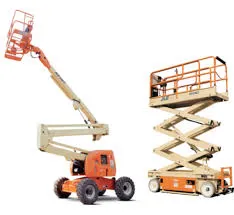Introduction
In today’s fast-paced industrial, commercial, and construction sectors, efficiency and safety are non-negotiable. One of the most common challenges across all these industries is working at height. From electrical installation to warehouse stocking, and from building maintenance to signage mounting, elevated work presents not only technical challenges but also safety concerns. That’s where specialized equipment like scissor lifts comes into play.
Scissor lifts provide a secure, efficient, and versatile method of reaching elevated work areas. These platforms are designed to lift workers and tools in a stable vertical motion, offering a safer and more productive alternative to ladders or scaffolding. However, not every business needs to own a scissor lift. For many, scissor lift rental is the most practical, cost-effective solution.
In this article, we’ll explore how scissor lifts work, the different types available, their benefits, safety tips, and why renting—rather than buying—can be the smarter business decision.
What Is a Scissor Lift?
A scissor lift is a type of mobile elevated work platform (MEWP) that moves vertically using a crisscrossed metal support system that opens and closes like a pair of scissors. The platform is mounted on this lifting mechanism and can accommodate workers along with their tools and materials.
Unlike boom lifts that provide horizontal reach, scissor lifts are intended purely for vertical access, making them ideal for tasks where you need to go straight up rather than out. Their compact size and straightforward controls make them easy to maneuver and use, even in confined indoor spaces or crowded construction sites.
Types of Scissor Lifts
Understanding the variety of scissor lifts available can help you choose the right model for your project. Whether you’re working indoors, outdoors, or on uneven surfaces, there’s likely a lift suited to your environment.
1. Electric Scissor Lifts
Electric lifts are battery-powered and ideal for indoor use. They are quieter than combustion-powered lifts, produce no emissions, and are often equipped with non-marking tires to protect indoor flooring.
2. Diesel Scissor Lifts
These are designed for outdoor use where more power and higher elevation are needed. Diesel lifts are rugged and capable of handling uneven terrain, making them suitable for construction and industrial sites.
3. Rough Terrain Scissor Lifts
Specifically built for harsh and uneven outdoor environments, these lifts feature heavy-duty tires, four-wheel drive, and outriggers for additional stability. They’re perfect for off-road conditions and large-scale outdoor projects.
4. Hydraulic and Pneumatic Lifts
These are used for lighter applications. Pneumatic models operate using compressed air, making them an environmentally friendly option where hydraulic fluid may be a hazard.
Key Benefits of Scissor Lifts
Scissor lifts are designed with functionality and safety in mind, providing numerous benefits over traditional access solutions.
1. Enhanced Safety
Compared to ladders or scaffolding, scissor lifts offer a secure working platform with guardrails and emergency stop functions. This significantly reduces the risk of falls and workplace injuries.
2. Time Efficiency
Workers can perform multiple tasks without needing to constantly reposition the equipment. Most scissor lifts can also carry multiple people and equipment, allowing tasks to be completed faster.
3. Versatility
From warehouses to outdoor construction, and from retail maintenance to sports arenas, scissor lifts are used across a wide range of industries and environments.
4. Reduced Physical Strain
By eliminating the need for climbing ladders or scaffolds repeatedly, scissor lifts reduce physical fatigue and improve worker morale.
Why Renting Makes More Sense
Although owning a scissor lift may seem attractive for companies with regular needs, in many cases, renting provides greater flexibility and cost savings. Here’s why scissor lift rental is a preferred choice for many businesses:
1. Cost Control
Purchasing a new scissor lift can be a significant investment, often ranging from $10,000 to $50,000 depending on specifications. Renting allows businesses to avoid upfront capital expenditure and pay only for the time they use the equipment.
2. No Maintenance Hassles
Rental companies handle all equipment servicing, ensuring the lift arrives in optimal condition. This reduces your responsibility for maintenance, repair, or regulatory compliance.
3. Variety and Flexibility
Different projects may require different types or sizes of scissor lifts. Renting allows you to choose the best equipment for each specific task without being stuck with a one-size-fits-all machine.
4. Storage and Transport Savings
When you rent, you don’t need to worry about long-term storage or the logistics of transporting heavy equipment. Most rental companies offer delivery and pickup, which simplifies planning and execution.
5. Access to the Latest Models
Equipment technology is always improving. Renting gives you access to newer, safer, and more efficient models without the depreciation that comes with ownership.
Common Applications of Scissor Lifts
Scissor lifts are used in a wide range of industries. Here are some of the most common applications:
- Construction and Renovation: For ceiling work, drywall installation, framing, and electrical systems.
- Warehouse Operations: Accessing high storage racks, inventory management, and facility maintenance.
- Event Production: Installing lighting rigs, hanging banners, and setting up staging elements.
- Building Maintenance: HVAC servicing, window cleaning, and painting in multi-story buildings.
- Retail Spaces: Interior decoration, security camera installation, and lighting upgrades.
Safety Guidelines and Best Practices
Using a scissor lift correctly is essential for the safety of your team and the success of your project. Follow these guidelines to minimize risk:
1. Operator Certification
Only trained and certified personnel should operate a scissor lift. Most jurisdictions require proof of training before equipment can be legally operated.
2. Pre-Use Inspection
Always inspect the equipment before use. Check the condition of tires, controls, guardrails, and emergency systems. Report any faults immediately to the rental company.
3. Use Fall Protection
Even though scissor lifts come with guardrails, it’s advisable to use personal fall arrest systems depending on the job site and local regulations.
4. Avoid Unsafe Conditions
Do not operate the lift in high winds or on unstable surfaces unless the equipment is specifically designed for such conditions.
5. Load Capacity Awareness
Never exceed the lift’s rated weight limit, including workers, tools, and materials. Overloading can result in equipment failure or tip-overs.
What to Look for in a Rental Provider
Choosing the right rental company is just as important as selecting the right equipment. Here’s what to consider when arranging a scissor lift rental:
- Reputation: Look for companies with strong reviews and a track record of reliability.
- Equipment Condition: Ensure their fleet is well-maintained and regularly serviced.
- Support Services: Choose providers that offer delivery, pickup, and on-call technical support.
- Transparency: The rental agreement should be clear about costs, timeframes, and liabilities.
- Variety of Options: A good rental provider should offer multiple models to suit different job requirements.
Cost Breakdown: What You Can Expect to Pay
The rental cost of a scissor lift depends on several factors such as platform height, lift type, duration of rental, and any additional services like delivery or damage waivers. Here’s a general idea of pricing:
| Type of Lift | Daily Rate | Weekly Rate | Monthly Rate |
| Electric (Indoor) | $100 – $150 | $300 – $500 | $800 – $1,200 |
| Diesel (Outdoor) | $200 – $350 | $600 – $900 | $1,500 – $2,500 |
| Rough Terrain (Heavy Duty) | $250 – $400 | $700 – $1,200 | $1,800 – $3,000 |
Keep in mind these are average estimates. Always request a custom quote tailored to your project and location.
Final Thoughts
In an era where safety, efficiency, and cost-effectiveness are more important than ever, scissor lifts provide a modern solution to traditional work-at-height challenges. Their adaptability and user-friendly features make them indispensable for countless industries.
For most short-term and even some long-term projects, scissor lift rental provides the flexibility businesses need to stay productive without the financial and logistical burden of ownership. From reduced costs to increased safety, the advantages are clear.
Whether you’re managing a construction site, performing facility upgrades, or setting up a major event, consider how a scissor lift—and more importantly, renting one—can elevate the success of your next project.






